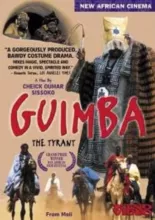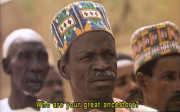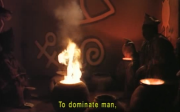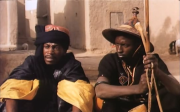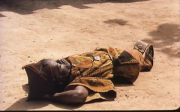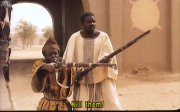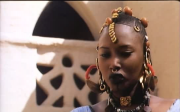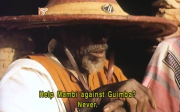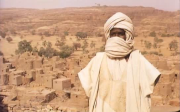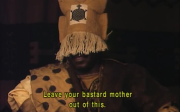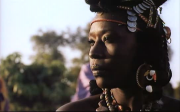MS You speak about a cinema of identity, but the position I see you take in your films is as a critique of Africa; the present Africa in
Finzan and the past in
Guimba. There is a particular attention to systems of power. In the cinema you do take a stance of opposition, would that be a fair assessment?
COS Cinema came out of a necessity to be able to communicate, to exchange with other people. Our continent is so very rich and so very beautiful, but also very behind. A continent that is coming out of colonialism, and consequently has practically nothing. How do we bring this change in power to the people? It is this question that made me choose to work in film. It is to show social progress, therefore I focus on the obstructions to progress, the struggles of our continent. Before
Finzan I did
Garbage Boys, on the tragedy of the children’s plight. Before
Garbage Boys, I did
Sécheresse et Exode Rural (
Drought and Rural Exodus), on the tragedy of the people of the earth, and after
Finzan I did
Guimba on the systems of power by using a metaphor borrowed from an old tale that embodies the situation of where I live. It it difficult for a filmmaker to have a specific position in relation to power. But overall, he or she can try to bring the audience to understand, through construction of the narrative, their rights and duties as Africans. I try to create a dialogue between the artist that I am, and the public I address. I must respect my history and the social structures in which I live, which I can do through my formation as a sociologist. Sociology is the best way to explore the cultures of our continent, and it through cinema where the public will then reflect themselves, find themselves, recognize themselves. This is why, when my films are shown, as with many other African films, there is this exclamation, this interjection when the audience sees the images.
MS Mali is a Muslim country, am I correct?
COS Yes.
MS What is the reception to your films? Is there opposition to the types of critiques you impose, for example the treatment of women, circumcision, etcetera? Are you equally as well received by the establishment as by the general public?
COS Mali is 110 percent Muslim, but it is a lay public. It is not an Islamic fundamentalist society. The women of Mali have not waited for the release of my films before organizing against female circumcision. There was already a Women’s Movement, there had already been a number of conferences organized about genital mutilation. There were some problems with the film because it brutally showed images of female circumcision. There were men who did not accept this film, and there was a national debate as a result of the film. I believe that in about two or three years from now, female circumcision will be illegal. There are already some legal propositions pending.
MS I would like to talk about different audiences for film. When I first saw
Finzan I was struck by two things; there were scenes of great power, dignity, almost tragic scenes followed by scenes of antics, buffoonery. It reminded me in a Shakespearean sense, of gearing the high drama to the nobles and the antics to the populous in the pit. Did you construct the film with two audiences in mind, as entertainment for the people and an intellectual element for another sector of the population?
COS There is effectively a duality, but more between the power of those who constitute the social basis of that power, and people of different levels in society who are trying to express themselves. And of course the children, who even if they are not aware of it, constitute the comic element of the film while representing
life itself. Above all the children are the hope, that when they become adults, they will no longer practice female circumcision, that they won’t enforce the veil for married women, no longer force widows to become the property of their husband’s brothers. On the other hand, there are the adults, who in their “seriousness” represent tradition and who are against life. I am not sure if that approaches Shakespeare but…
MS On the subject of audiences, can we talk about the distribution of your films within the African continent? Are they able to be seen by a wide audience, using the word “able” in a very pointed sense, because there are problems in distribution. Do you have the distribution that you want in Africa or are you shown more on the international film circuit?
COS The question of film distribution on our continent is like a thorn in our sides. We are making more and more films, more and more good films, but it is a difficult process, trying to distribute them in Africa and elsewhere. In Africa it is even more dramatic because my intention is to make a film, and then show it throughout the continent. Then, show it elsewhere because we must make up for the tragic absence of our images among the universe of images. First, we must be able to construct our own identity, to make known to the world our culture and history, to that for future interactions, the outside world will be able to know who we are and try to understand us, and will recognize the great value of our African civilization.
We are still in the “do-it-yourself” stage of our cinema’s development, so we must physically accompany our films from country to country in Africa in order to reach a wider audience. This was the beginning tenants of an inter-African cooperation to distribute our films, the CCDC:
Centre de Circulation et de Distribution du Cinema, which united 14 countries and permitted the circulation of our films. That was an excellent project. But poor management did not permit the continuation of the program, and the CCDC was closed. Nothing has replaced this institution and the American films are the ones that continue to saturate African theaters as they are distributed tried by European multinational corporations who have links in Africa.
There is a second problem that impedes the distribution of African film, which is the question of language. 40 to 60 percent of the population has knowledge of the alphabet. The African public has a desire to see African film, and each time we go to another country to show our films first, there is a large turnout. But there are limits to how much the image can communicate, so the question of language arises. How can we find a way to dub our films in the national languages of Africa?
MS But wouldn’t there also be a problem for American films in terms of language barriers? Wouldn’t they also need to be subtitled or dubbed?
COS It is not always necessary for them to be translated, even if we don’t understand everything, that isn’t important…those are films about violence.
Rambo is not a film in which we have a need to understand the dialogue. Police/action films are the same in that sense. We are habituated to the level of violence, and the public then identifies with the main character who leads them through the narrative. He is “goodness;” the best, the strongest, and the force who fights against evil. These sorts of film do not force the public to reflect deeply upon the narrative structure and this is why these films can be well received in Africa. It is a bit sad that these films represent the vision of the West for us.
As for the problem of language in terms of African film, there are very few films that are screened. It is in fact the large film festivals that permit our films to reach a wide audience, for example the
Festival de Cannes. But at Cannes it is incredibly rare that a film is shown: There is a maximum of one African film a year that is part of their
Palme d’Or competition.
 Film stills from Sissoko’s Guimba © Kino International. Courtesy King Video.MS
Film stills from Sissoko’s Guimba © Kino International. Courtesy King Video.MS But there are now many festivals specific to African film, which in a sense poses a problem. These films are being isolated rather than being seen at part of an international film community, sort of like rare and exotic offerings. And there are types of films made only for Western eyes.
COS This is a very good question. There is a danger that films are being made exclusively for such festivals. There are, on the other hand, festivals that exist (even in Europe) such as the
Festival d’Angers and the Festival of Milan that try to make it possible for African film to be accepted by a larger public. Such festivals start the process of making our cinema known. It is important to have such festivals, and it is especially important in the United States. There are the beginnings of some very large communities of recent African immigrants here in America. America will be able to know Africa by looking through our eyes.
MS On a national level, what steps would you like to see happen in Africa to promote and protect the industry? Do you think governments should intervene?
COS All governments should be obliged to invest themselves in all aspects of life of their citizens. Cinema is part of culture and the government should recognize it as an important media, a means to combat the images that we receive by satellite that we cannot control. Africa’s rhythm of life is dictated by the images coming from the north, which we receive all the time. And if we do not fight against these images, we will start thinking like Americans, like French, British, and Germans. So we must develop our national television as well as our national cinema. There are many countries in Africa which are not particularly interested in film, they follow the American model and say that it is a matter for private domain. But the African states that have political support for filmmaking, the states that I am most engaged with, these states need to construct national institutes for cinema in cooperation with other interested countries. It is impossible to construct a film industry in only one African country, so African governments must collaborate. There are already laboratories existing in Nigeria, Zimbabwe, South Africa, Morocco, Algeria, and Tunisia. We have no need to blind our facilities from scratch. On the other hand, we must try to initiate a post-production network in the five regions of Africa as determined by the United Nations. These post-production facilities, including the possibility of dubbing films, would provide not only an easily accessible space for filmmakers, but would also offer a preferential cost. When we go to Europe to do post-production it is very expensive. The government could also provide material for filmmakers to rent and borrow to increase film production.
MS How would that happen? What will make the governments move to make such concessions?
COS First of all, the filmmakers must have solidarity, and this can be encouraged by the
Federation Pan Africaine des Cineastes. There are also governments, such as Burkina Faso, that are already well organized in supporting filmmaking activities. I believe it is within reason to expect these things from the government. As of now, we are receiving the majority of our funding from France and the European Union, which will one day cease to be. Then, there must be the possibility to put into place a filmmaking fund. We can also try to gain financial autonomy which can be achieved by having our films dubbed in the national languages of Africa, permitting them to be seen throughout the continent, thus making profits at the box office. If we then put a certain percentage of these profits into a shared film fund, as in Burkina Faso, where between 5 to 10 percent of profit from a film goes into a national fund, there will be money to fund future films as well as the construction of movie theaters.
MS This model has existed in Burkina Faso since the ‘60s—a gap of some 30 years and no one has followed their model? It seems like a utopian model, so why no progress?
COS Very early on, Burkina Faso hosted an African film festival, which is in its 25th year. Burkina Faso’s government recognized the importance of culture, not only cinema, but also theater, dance, and craft production. In 1993 there was a revolutionary power led by Blaise Compaoré, which wanted to change the system. It eradicated many things and showed that culture is indispensable to the country’s development.
MS So, to a certain extent you can see in film a tool of revolutionary change for African society. Where is your future direction going in film?
COS I chose to work in film because of the possibilities of expression and to create change. I started my studies in mathematics, and I moved to cinema studies. Not theater and not literature, art forms with a language that is somewhat inaccessible to a majority of people. With the power of images coupled with our national Malian language, I could better explain the phenomena that control our society.
Cinema also works to assure our artistic autonomy, that is to say, to preserve the dialogue between the filmmaker and his public to communicate social realities and to tell a story. It is with this intent that I started making the films
Garbage Boys and
Finzan, but I developed it more precisely with
Guimba. As Africans, we have a narrative style that comes from our strong oral tradition. There is a certain way of constructing our narratives so that they are fixed in our collective memories. The storytellers have a way of telling their tales where the people realize that they are a part of the story. What is manifested in them then is the words, the arguments, and the force with which they are told. Now we use this oral tradition in relation to the cinemagraphic image, to construct a story with a similar sort of punctuation. My work is focused, in a certain way, to see if we can actually create an African film aesthetic.
In
Garbage Boys, there was no storyteller as character, there was just myself and the camera. I was present in the story, even if I am not in the film. When the film is shown again in two hundred years, I will still be in the present in the film. Cinematically, how do I translate this process? In
Garbage Boys, I use a mise-en-scène documentary style that is accompanied with a voice-over, and I followed the principle characters as they walked along the alleys and streets to show the everyday life of the people of the city. I used the same strategy in
Finzan, when the woman leaves the village to go to the city we see her in very animated streets, with other women. She is overwhelmed by what she sees, only the women are working in this city. This is to show that she is not the only person who is exploited, but in fact all of the women are in the same situation. This was my first try using this style of constructing a narrative critique. In
Guimba, the script was written from the perspective of a narrator who is also a character in the film. I did not want to write the script in a “classic” manner, I wanted to be faithful to this style of storytelling intrinsic to my culture. This next century will be especially important for African cinema, if we succeed in translating our legends, stories, and history into film. These stories have a thematic freshness and a profound humanism that is particularly African.
MS Can I ask you one question about
Guimba in regards to the creation of an African visual aesthetic? The textures, the fabrics, color, and architecture in
Guimba was extraordinary. You could almost feel, touch, and smell the Africa you were depicting.
COS In order to achieve such a visual affect, I had to put a call out to two great artists and good friends of mine, Seeasave for the costumes and Baba Kieta for the sets. They are part of a group who are involved in current artistic production in Mali, named Groupe Kasubone. These are men of incredible talent, although they are not well known. They have a collection of extraordinary necklaces, for example. I asked them to help me in showing the stunning beauty of our Malian culture since the Middle Ages: The harmony between our costumes, architecture, and animal representations in the film, and how they come to express the importance of harmony and humanism in our culture. The Griot (storyteller) has the power to evoke these images with his words and an African man can close his eyes and easily conjure what the Griot is speaking about. But we intended to reconstruct these images to show to the audience what kind of society historically existed in Mali.
 Sissoko on the set of Guimba.MS
Sissoko on the set of Guimba.MS Future directions, where next?
COS The next film will be from Genesis, the first book of the Bible. A friend of mine proposed the project to me when I began to explain to him what worried me in the world today. The problem of intolerance and the tearing apart of countries, in Africa and other parts of the world, is increasing. I have never done a film that was not dictated by a sense of urgency. I have never written a film script just because the subject matter pleased me.
Garbage Boys was made to discuss the situation of children who live on the streets.
Finzan was the dramatic situation of women in the society, which I witnessed myself and then was the catalyst for the film.
Guimba was about the events of 1990, which lead to the fall of the dictatorship. I had the need to speak about power in Africa and the richness of our humanity and spirituality. One has to realize that Africa is an incredibly rich and beautiful continent, but as it modernizes it also deteriorates. There are schisms in more and more African countries: Rwanda, Burundi, Angola…throughout the continent. We have to speak of these problems, which brings me to my next project. Communities need to have a reason to love each other and not create war.
So then, my friend looked for a story in the book of Genesis, and settled on the story of Jacob, his sons, and his neighbors. The Bible is linked to the three major religions in humanity: Judaism, Christianity, and Islam. For this reason, everyone will be able to find a bit of themselves in this film, and it is an ideal vehicle to speak about this problem of nationalist conflict.
In 1997, I have a film project called
L’Acte Fatale, proposed by a French producer named Jean-Pierre Dusard. I read his scenario and I gave my consent to doing the project. The actor who is to play the main role is Youssou N’Dour, a famous Senegalese singer who was introduced to the West by Peter Gabriel. From June to August I will be filming
Genesis. The large project that I wish to realize is
L’Enfant Peul, a story from oral tradition written by Amadou Hampåté Bå which tells a tale that stretches from his childhood during the end of the great royal provinces of Africa, through the period of colonialism to the end of colonialism.
MS What are the national languages of Africa?
COS English and French are the “official languages” and they are only spoken by 30–40 percent of the people. The indigenous languages are regional, in West Africa it is Mandingo, Fulani, Olasa, Yoruba, and Igbo. In East Africa, all the countries speak Swahili. And in South Africa it is principally Zulu.
MS Where is the funding coming from for these next projects? From France again?
COS Africa for the first one, specifically Burkina Faso. Perhaps also some European television funding.
MS And who are the funders in Africa, is it business, government, or the television network?
COS Mostly individuals and government funding. There are two African film producers, one in Mali and one in Burkina Faso.
MS Does African funding mean less restrictions and interference in your projects?
COS That actually depends on the personality of the filmmaker. I never change my projects. If they don’t accept my project, of course I am open to discuss it, but if it changes the spirit or content of my project, I will not accept the funding.
 Guimba Un Tyran Une Époque - Cheikh Oumar Sissoko 1995.avi [699.50 Mb]
Guimba Un Tyran Une Époque - Cheikh Oumar Sissoko 1995.avi [699.50 Mb] 
